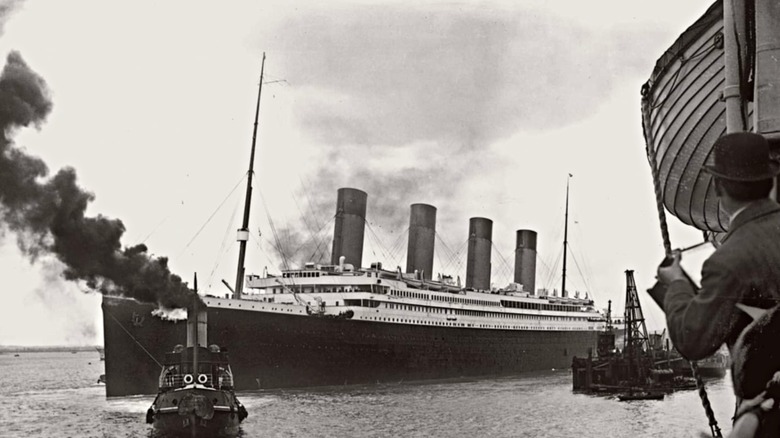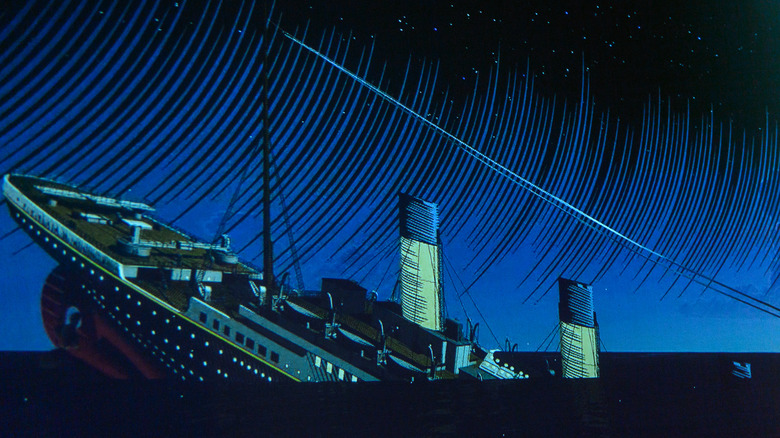Does History Reveal How Big The Titanic's Iceberg Was?
According to National Geographic, the Titanic departed on its maiden voyage on April 10, 1912. The luxury liner left Southampton, England and was headed to New York City. Britannica writes that the Titanic offered a number of lavish amenities, including elevators, a swimming pool, and more. Unsurprisingly, several wealthy individuals made their way on board to enjoy the ship's opulence. Per History, the Titanic was believed to be "unsinkable." However, unbeknownst to the 2,240 passengers, the vessel had a series of safety flaws. For instance, there were only 20 lifeboats for all of them if something was to go awry.
And something did indeed go awry. Minutes before midnight on April 14, the Titanic hit an iceberg, damaging its hull (via the BBC). Seawater poured in and the ship began to sink in the early hours on April 15, about 370 miles from the coast of Newfoundland. The ship eventually broke in two and made its way to the bottom of the Atlantic Ocean.
Ultimately, All That's Interesting reports that more than 1,500 people died as a result of the disaster. A majority were third class passengers, as they were sequestered farther from the lifeboats. Likewise, the water temperature was at an icy 27 degrees (per The Cold Wire). Although the Titanic's wreckage was discovered on the ocean floor in 1985, Gizmodo reports that several photos of the alleged iceberg exist to provide insight on its size and fate.
The exact size of the iceberg is unknown
The Coast Guard writes that it's believed that the iceberg that hit the Titanic was massive. Although there are no exact measurements, it's reported to have been anywhere from 50 to 100 feet tall and the length to be at 200 to 400 feet. Titanic Facts explains that only 10% of the iceberg was visible when it crashed with the vessel; the rest was underwater.
In 2016, it was estimated that the iceberg was 100,000 years old and came from a group of glaciers in Greenland, per the New York Daily News. The original glacier from Greenland was colossal compared to the iceberg that broke off and eventually caused the Titanic's demise. Nonetheless, the iceberg is thought to have weighed 1.5 metric tonnes, or over 3,000 pounds.
Gizmodo reports that shortly after the ship's sinking, several photos were taken of what was believed to be the notorious iceberg by crew members of other nearby ships. Each photo displays flecks of red paint which were believed to be proof that this was indeed the iceberg that damaged the Titanic. Unfortunately, it could never truly be proved. As explained by Wired, the water's temperature was too warm for the iceberg and it most likely melted sometime in 1912 or in 1913.
The titanic received several ice warnings
Hours before the Titanic sank, the liner had received word that icebergs were on its path (via Titanic Facts). In fact, five telegraphs were sent between 9 a.m. and 9:40 p.m. on April 14 from different vessels. Each one of them warned Titanic of colossal-sized icebergs. However, Titanic: The Legend, Myths, and Folklore writes that the captain of the ship, Edward John Smith, received all of them, except for the last one. It's unknown why this occurred. Whatever the case, the ship paid little attention to these warnings and failed to reduce its speed (per The Guardian).
Per Titanic Facts, the ship collided with the iceberg at 11:40 p.m. Although the iceberg had been seen by crew members in the crow's nest, it was too late to steer the Titanic away from disaster. NBC News reports that other factors also led to the crash, including the ship's high speed and the weather conditions, which ultimately caused the emergence of several icebergs.
According to CBS News, the Titanic's wreckage is on the verge of vanishing forever. As it lays on the ocean floor, it's being dissolved by iron-eating bacteria. Researchers believe it will be completely gone by 2030 (via Insider).


